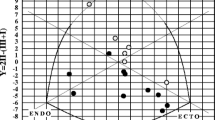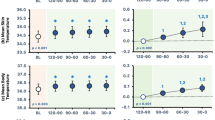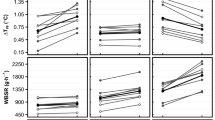Abstract
Seasonal variations in day length and light intensity can affect the circadian rhythm as well as some characteristics of temperature regulation. We investigated characteristics of autonomic (ATR), behavioural (BTR) and nocturnal (NTR) temperature regulation during spring and autumn. Eleven participants underwent experiments in both seasons. To assess ATR, participants performed a 30-min bout of submaximal upright exercise on a cycle ergometer, followed by 100 min of water immersion (28 °C). Thresholds for the onset of shivering and sweating and vasomotor response were measured. BTR was assessed using a water-perfused suit, with participants regulating the water-perfused suit temperature (Twps) within a range, considered as thermally comfortable. The Twps changed in a saw-tooth manner from 10 to 50 °C; by depressing a switch, the direction of the Twps changed, and this limit defined the thermal comfort zone (TCZ) for each participant. A 24-h proximal (calf)–distal (toe) skin temperature gradient (∆Tc-t) was measured to assess NTR. Initiation of vasomotor tone, shivering and sweating was similar between trials. Width of the TCZ was 8.1 °C in spring and 8.6 °C in autumn (p = 0.1), with similar upper and lower regulated temperatures. ∆Tc-t exhibited a typical circadian rhythm with no difference between seasons. Minor changes in skin temperature and oxygen consumption (p ˂ 0.05) between the seasons may indicate a degree of seasonal adaptation over the course of winter and summer, which persisted in spring and autumn. Other factors, such as country, race, sex and age could however modify the outcome of the study.


Similar content being viewed by others
References
Andrade H, Alcoforado M-J, Oliveira S (2011) Perception of temperature and wind by users of public outdoor spaces: relationships with weather parameters and personal characteristics. Int J Biometeorol 55:665–680
ANSI/ASHRAE (2013) Standard 55. Thermal Environmental Conditions for Human Occupancy, American Society Of Heating, Ventilating and Air-conditioning Engineers, Atlanta:
Aoki K, Yokoi M, Masago R, Iwanaga K, Kondo N, Katsuura T (2005) Modification of internal temperature regulation for cutaneous vasodilation and sweating by bright light exposure at night. Eur J Appl Physiol 95:57–64. https://doi.org/10.1007/s00421-005-1392-6
ARSO (2013) Our environment. Slovenian Environment Agency, Ljubljana
Au-Yong IT, Thorn N, Ganatra R, Perkins AC, Symonds ME (2009) Brown adipose tissue and seasonal variation in humans. Diabetes 58:2583–2587. https://doi.org/10.2337/db09-0833
Bain AR, Jay O (2011) Does summer in a humid continental climate elicit an acclimatization of human thermoregulatory responses? Eur J Appl Physiol 111:1197–1205
Berson DM, Dunn FA, Takao M (2002) Phototransduction by retinal ganglion cells that set the circadian clock. Science 295:1070–1073. https://doi.org/10.1126/science.1067262
Bruck K, Wunnenberg W, Gallmeier H, Ziehm B (1970) Shift of threshold temperature for shivering and heat polypnea as a mode of thermal adaptation. Eur J Phys 321:159–172
Ciuha U, Eiken O, Mekjavic IB (2015) Effects of normobaric hypoxic bedrest on the thermal comfort zone. J Therm Biol 49-50: 39-46. doi:https://doi.org/10.1016/j.jtherbio.2015.02.001
Ciuha U, Mekjavic IB (2016) Regional thermal comfort zone in males and females. Physiol Behav 161:123–129. https://doi.org/10.1016/j.physbeh.2016.04.008
Ciuha U, Mekjavic IB (2017) Thermal comfort zone of the hands, feet and head in males and females. Physiol Behav 179:427–433. https://doi.org/10.1016/j.physbeh.2017.07.020
Guler AD, Ecker JL, Lall GS, Haq S, Altimus CM, Liao H-W, Barnard AR, Cahill H, Badea TC, Zhao H, Hankins MW, Berson DM, Lucas RJ, Yau K-W, Hattar S (2008) Melanopsin cells are the principal conduits for rod-cone input to non-image-forming vision. Nature 453:102–105. https://doi.org/10.1038/nature06829
Hattar S, Liao HW, Takao M, Berson DM, Yau KW (2002) Melanopsin-containing retinal ganglion cells: architecture, projections, and intrinsic photosensitivity. Science 295:1065–1070. https://doi.org/10.1126/science.1069609
Honma K, Honma S, Kohsaka M, Fukuda N (1992) Seasonal variation in the human circadian rhythm: dissociation between sleep and temperature rhythm. Am J Phys 262:885–891. https://doi.org/10.1152/ajpregu.1992.262.5.R885
House JR, Tipton MJ (2002) Using skin temperature gradients or skin heat flux measurements to determine thresholds of vasoconstriction and vasodilatation. Eur J Appl Physiol 88:141–145. https://doi.org/10.1007/s00421-002-0692-3
Ibsen B (1967) Treatment of shock with vasodilators measuring skin temperature on the big toe: ten years’ experience in 150 cases. Diseases of the Chest 52:425–429
Ihzuka H, Hori S, Akamatsu T (1986) Seasonal variations of physiological responses to heat of subtropical and temperate natives. Int J Biometeorol 30:107–113
Inoue Y, Nakao M, Okudaira S, Ueda H, Araki T (1995) Seasonal variation in sweating responses of older and younger men. Eur J Appl Physiol Occup Physiol 70:6–12
Jacquot CM, Schellen L, Kingma BR, van Baak MA, van Marken Lichtenbelt WD (2014) Influence of thermophysiology on thermal behavior: the essentials of categorization. Physiol Behav 128:180–187. https://doi.org/10.1016/j.physbeh.2014.01.025
Joly HR, Weil MH (1969) Temperature of the great toe as an indication of the severity of shock. Circulation 39:131–138
Kakitsuba N, Mekjavic IB, Katsuura T (2011) The effect of season and light intensity on the core interthreshold zone. J Physiol Anthropol 30:161–167. https://doi.org/10.2114/jpa2.30.161
Kakitsuba N, Mekjavic IB, Katsuura T (2013) The core interthreshold zone during exposure to red and blue light. J Physiol Anthropol 32:6. https://doi.org/10.1186/1880-6805-32-6
Keramidas ME, Kölegård R, Mekjavic IB, Eiken O (2016) PlanHab: hypoxia exaggerates the bed-rest-induced reduction in peak oxygen uptake during upright cycle ergometry. Am J Phys Heart Circ Phys 311:H453–H464
Kräuchi K, Cajochen C, Werth E, Wirz-Justice A (1999) Warm feet promote the rapid onset of sleep. Nature 401:36–37
Krauchi K, Wirz-Justice A (1994) Circadian rhythm of heat production, heart rate, and skin and core temperature under unmasking conditions in men. Am J Phys Regul Integr Comp Phys 267:R819–R829
Lima A, Bakker J (2006) Noninvasive monitoring of peripheral perfusion. Applied Physiology in Intensive Care Medicine. In: (ed.) Applied Physiology in Intensive Care Medicine. Springer, 131-141
Lindner-Cendrowska K, Błażejczyk K (2013) Clothing habits during tourism and leisure activities in urban areas. The case study of Warsaw (Poland). Editors: James D Cotter, Samuel JE Lucas and Toby Mündel: 288
Lindner-Cendrowska K, Błażejczyk K (2018) Impact of selected personal factors on seasonal variability of recreationist weather perceptions and preferences in Warsaw (Poland). Int J Biometeorol 62:113–125
McDonnell AC, Eiken O, Mekjavic PJ, Mekjavic IB (2014) Circadian rhythm of peripheral perfusion during 10-day hypoxic confinement and bed rest. Eur J Appl Physiol 114:2093–2104. https://doi.org/10.1007/s00421-014-2923-9
Mcintosh AM, Sussmann J, Goodwin G (2010) Mood disorder. Companion to psychiatric studies In: Johnstone EC, Cunninghan Owens D, Lawrie SM, Mcintosh AM, Sharpe M (ed.) Companion to psychiatric studies Elsevier, 427-452
Mekjavic IB, Golja P, Tipton MJ, Eiken O (2005a) Human thermoregulatory function during exercise and immersion after 35 days of horizontal bed-rest and recovery. Eur J Appl Physiol 95:163–171. https://doi.org/10.1007/s00421-005-1348-x
Mekjavic IB, Kocjan N, Vrhovec M, Golja P, House C, Eiken O, 2005b: Foot temperatures and toe blood flow during a 12 km winter hike and guard duty. LJUBLJANA UNIV (YUGOSLAVIA) JOZEF STEFAN INST
Mekjavic IB, Sundberg CJ, Linnarsson D (1991) Core temperature “null zone”. J Appl Physiol 71:1289–1295. https://doi.org/10.1152/jappl.1991.71.4.1289
Meyer C, Muto V, Jaspar M, Kusse C, Lambot E, Chellappa SL, Degueldre C, Balteau E, Luxen A, Middleton B, Archer SN, Collette F, Dijk DJ, Phillips C, Maquet P, Vandewalle G (2016) Seasonality in human cognitive brain responses. Proc Natl Acad Sci U S A 113:3066–3071. https://doi.org/10.1073/pnas.1518129113
Ramanathan NL (1964) A new weighting system for mean skin temperature of the body. J Appl Physiol 19:531–533. https://doi.org/10.1152/jappl.1964.19.3.531
Rubinstein EH, Sessler DI (1990) Skin-surface temperature gradients correlate with fingertip blood flow in humans. Anesthesiology 73:541–545
Schell LM, Knutson KL, Bailey S (2012) Environmental effects on growth human growth and development (second edition). In: Bogin B (ed.) Human growth and development (second edition). Academic Press, 245-286
Shephard RJ, Aoyagi Y (2009) Seasonal variations in physical activity and implications for human health. Eur J Appl Physiol 107:251–271
Stevens RG (2006) Artificial lighting in the industrialized world: circadian disruption and breast cancer. Cancer Causes Control 17:501–507
Stoner H, Barker P, Riding G, Hazlehurst D, Taylor L, Marcuson R (1991) Relationships between skin temperature and perfusion in the arm and leg. Clin Physiol 11:27–40
Tayefeh F, Plattner O, Sessler DI, Ikeda T, Marder D (1998) Circadian changes in the sweating-to-vasoconstriction interthreshold range. Pflugers Arch 435:402–406. https://doi.org/10.1007/s004240050530
Van Dongen HP, Kerkhof GA, Souverijn JH (1998) Absence of seasonal variation in the phase of the endogenous circadian rhythm in humans. Chronobiol Int 15:623–632
van Ooijen AMJ, van Marken Lichtenbelt WD, van Steenhoven AA, Westerterp KR (2004) Seasonal changes in metabolic and temperature responses to cold air in humans. Physiol Behav 82:545–553. https://doi.org/10.1016/j.physbeh.2004.05.001
Van Someren EJW (2004) Sleep propensity is modulated by circadian and behavior-induced changes in cutaneous temperature. J Therm Biol 29:437–444. https://doi.org/10.1016/j.jtherbio.2004.08.003
Wehr TA, Giesen HA, Moul DE, Turner EH, Schwartz PJ (1995) Suppression of men’s responses to seasonal changes in day length by modern artificial lighting. Am J Phys Regul Integr Comp Phys 269:R173–R178
Funding
The research leading to these results has received funding from the European Union’s Framework Programme (2007–2013) under grant agreement no. 284438.
Author information
Authors and Affiliations
Corresponding author
Additional information
Publisher’s note
Springer Nature remains neutral with regard to jurisdictional claims in published maps and institutional affiliations.
Rights and permissions
About this article
Cite this article
Ciuha, U., Kounalakis, S., McDonnell, A.C. et al. Seasonal variation of temperature regulation: do thermoregulatory responses “spring” forward and “fall” back?. Int J Biometeorol 64, 1221–1231 (2020). https://doi.org/10.1007/s00484-020-01898-w
Received:
Revised:
Accepted:
Published:
Issue Date:
DOI: https://doi.org/10.1007/s00484-020-01898-w




